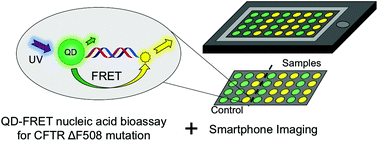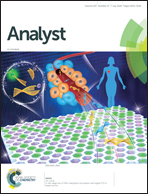Detection of cystic fibrosis transmembrane conductance regulator ΔF508 gene mutation using a paper-based nucleic acid hybridization assay and a smartphone camera†
Abstract
Diagnostic technology that makes use of paper platforms in conjunction with the ubiquitous availability of digital cameras in cellular telephones and personal assistive devices offers opportunities for development of bioassays that are cost effective and widely distributed. Assays that operate effectively in aqueous solution require further development for implementation in paper substrates, overcoming issues associated with surface interactions on a matrix that offers a large surface-to-volume ratio and constraints on convective mixing. This report presents and compares two related methods for determination of oligonucleotides that serve as indicators of cystic fibrosis, differentiating between the normal wild-type sequence, and a mutant-type sequence that has a 3-base replacement. The transduction strategy operates by selective hybridization of oligonucleotide probes that are conjugated to fluorescent quantum dots, where hybridization of target sequences causes a molecular fluorophore to approach the quantum dot and become emissive through fluorescence resonance energy transfer. Detection can rely on hybridization of a target that is labelled with Cy3 fluorophore, or in the presence of an unlabelled target when a sandwich assay format is implemented with a labelled reporter oligonucleotide. Selectivity to determine the presence of mismatched sequences involves appropriate selection of nucleotide sequences to set melt temperatures, in conjunction with control of stringency conditions using formamide as a chaotrope. It was determined that both direct and sandwich assays on paper substrates are able to distinguish between wild-type and mutant-type samples.



 Please wait while we load your content...
Please wait while we load your content...